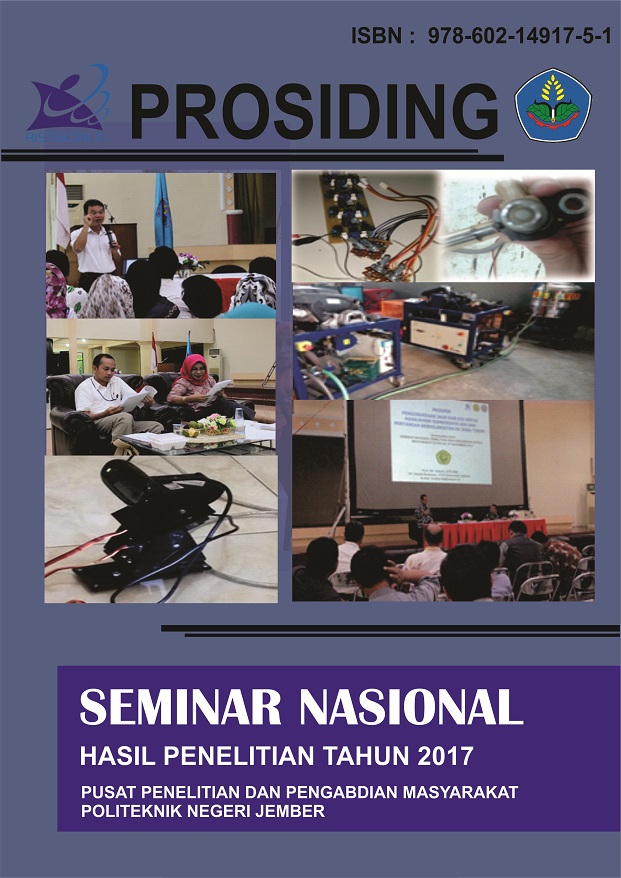Optimalisasi Fungsi Bunga Refugia Sebagai Pengendali Hama Tanaman Padi (Oryza sativa L.)
Abstract
The objectives of this study were to assess the insect population and highest population status on paddy refugia field, and to increase production by improving the quality of maintenance. The benefits of this research is to provide information on the agricultural world on integrated pest control applications. This research was conducted from August to October 2017 in Suren Village, Ledokombo Subdistrict, Jember District and refufia which is used is refugia seeds, namely kenikir (Cosmos caudatus) and paper flowers (Zinnia elegans) and ciherang rice seeds. Refugia is planted simultaneously with rice. Random sampling is systematic (zigzag pattern). The variables observed in this research are investment and classification of insect population. The data collection procedure uses primary data collection method. Population of insect pest, predator and parasitoid highest on observation of rice plant age at age 3, 4 and 5 weeks after planting. While the population of insect pest, predator and parasitoid lowest on observation of age of rice plant and plant refugia age 1 and 2 weeks after planting. Pests identified in rice plants and refugia are green leafhoppers, brown planthopper, broodstock, leaf borer and green grasshopper. Total natural enemies in rice plants without refugia plants as many as 305 heads, rice plants with Refugia plant as many as 438 heads, it can be seen that in rice plants with plants Refugia larger population of natural enemy insects Keywords— Cosmos caudatus, integrated pest management, Zinnia elegan, RefugiaÂ
References
Altieri MA dan Toledo VM,â€The agroecological revolution in Latin America: rescuing nature, ensuring food sovereignity and empowering peasants†J Peasant Stud 38:587–612. 2011.
Azmi, S. L. Leksono, A. S, Yanuwiadi, B. Arisoesilaningsih, E. 2014. Diversitas Arthropoda Herbivor Pengunjung Padi Merah di Sawah Organik di Desa Sengguruh, Kepanjen. J-PAL. 5(1): 57-64.
Baehaki SE, Arifin K, Munawar D,â€Peran Varietas Tahan dalam Menurunkan Populasi Wereng Coklat Biotipe 4 pada Tanaman Padi†Penelitian Pertanian Tanaman Pangan 30(3): 145-153.2011.
Baehaki, “Tanam padi berjamaah berlandaskan triangle strategis dalam pencapaian surplus beras 10 juta tonâ€, Sinar Tani 3478 (13):1-8. 2012.
Bahagiawati, “Manajemen Resistensi Serangga Hama pada Pertanaman Tanaman Transgenik Bt. Buletin AgroBioâ€, 4(1). 2001
Balai Besar Penelitian Tanaman Padi. 2009. Hama Walang Sangit (Leptcorisa oratorius). http://bbpadi.litbang.deptan.go.id/
Letourneaua, D. and Miguel, A. 2003. Vegetation management and biological control in agroecosystems. Journal of Biological Control. University of California, Berkeley, Albany CA94706, USA.
Lu W, Hou M L, Wen J H, Li J W, “Effects of plant volatiles on herbivorous insectsâ€, Plant Protection 33: 7-11. 2007
Marhub, E. 1998. Struktur Komunitas Arthopoda pada Ekosistem Padi Tanpa Perlakuan Fungisida. Jurnal. Jurusan Hama Penyakit Tumbuhan Faultas Pertanian Universitas Gadjah Mada. Yogyakarta
Parker JE, Synder WE, Hamilton GC,Rodrigouz-souna C 2013. Companion Planting and Insect Pest Control: Chapter 1. http://dx.doi.org/10.5772/55044.
Pasaribu B, “Rancangan Undang-undang Lahan Pangan Abadi. Tidak Memperkenankan Konversi Lahan Panganâ€,Sinar Tani 3:8-14. 2006
Powell W., 1986. Enhancing parasitoid activity in crops. Di dalam : Waage J, Greathead D (ed.). Insect Parasitoid. Academic Press, Orlando.
Rizka N, Rochman F, Suhadi. 2015. “Kajian Jenis Hama Dan Efektivitas Pola Tanam Tanaman Repellent Terhadap Penurunan Kepadatan Populasi Hama Penting Pada Tanaman Brokoli (Brassica oleracea L. var Italica)â€. http://jurnal-online.um.ac.id
Rugaya A dan Dahyar, Identifikasi Biotipe Wereng Batang Coklat Nilaparvata lugens Stal (Delphacidae, Homoptera) Kaloni Kabupaten Takalar. Seminar Nasional Inovasi Teknologi Pertanian. Hal: 227-237. 2006,
Sholih, M dan Ainun, Y, 2016, Hama Wereng Mulai Serang Padi di Jember.http://m.banyuwangi.timesindonesia.co.id/read/1142/20151221/185330/abdullah-azwar-anas-siap-ditetapkan-sebagai-bupati.
Stan F, Helen B and Rosemary H C. 2003. “Companion planting – do aromatic plants disrupt host-plant finding by the cabbage root fly and the onion fly more effectively than non-aromatic plants†Entomologia Experimentalis et Applicata.109:183-195.
Sukaromah, B. Yanuwiadi, “Preferensi Serangga Coccinelidae untuk memilih tumbuhan familia Asteraceaeâ€. Bioscientiae 3(1). 2006
Suprihatin, A. 2017. Pemanfaatan gulma di halaman kampus pppptk boe malang sebagai media pembelajaran pendidikan lingkungan hidup (mata diklat pestisida nabati). Pusat Pengembangan dan Pemberdayaan Pendidik dan Tenaga Kependidikan Bidang Otomotif dan Elektronika. Malang.

